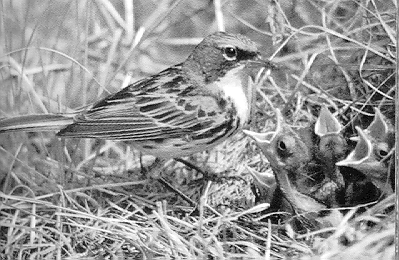Nathan Leopold's hobby was ornithology. Leopold spent many hours, especially in the spring, hiking through the woods and swamps in the Chicago area in search of unusual birds. Like many serious birders of the time, Leopold collected birds--that is, he shot and bagged them for close-up study. He kept about 3,000 bird specimens in the third-floor study of his home.
Leopold shared his interest in birds with others. He lectured on the subject at the nearby Harvard School and taught, as an unpaid volunteer, a "bird class" to girls from the University Elementary School.
Leopold's birding expeditions frequently took him to the South Chicago swampland near the Indiana line where he and Loeb stuffed the body of Bobby Franks in a concrete culvert. Leopold birded in the area a "half a dozen times" in the two weeks before the murder. On May 21, 1924, the day of the Franks murder, Leopold wore one of two old suits he called his "birding suits"--suits that were no longer good enough to wear for school. In the breast pocket of the suit was the pair of reading glasses which eventually led to his arrest. When asked by State's Attorney Robert Crowe to explain the presence of his glasses near the body, Leopold said that they must have fallen out when he and two birding companions were near that location. He tripped near there, he said, while running in his rubber boots to get a shot at a Wilson's phalarope, a shorebird rarely seen in the Chicago area. His several attempts to demonstrate how the glasses might have fallen out of his coat pocket failed.
Leopold renewed his interest in ornithology upon his move to Puerto Rico in 1960, following his release from Joliet prison. Leopold spent much of his free time in the island forests observing birds. He published a book entitled "A Checklist of the Birds of Puerto Rico."
Nathan Leopold had a special interest in a rare songbird called the Kirtland's Warbler. At the time of the Franks murder, Leopold probably knew more about the Kirtland's Warbler than anyone in the country. In the summer of 1923, Leopold travelled to northern Michigan in search of the warbler. In October, Leopold went to Boston where he delivered a paper on the Kirtland's Warbler at the the annual meeting of the American Ornithological Union.

The Kirtland's Warbler (Dendroica Kirtlandii) is a rare wood warbler first discovered in 1851. The species was named after an Ohio naturalist, Dr. Jared P. Kirtland. The first Kirtland's Warbler nest was not discovered until 1903 near the AuSable River in Oscoda County in northern lower Michigan. Every nest found since has been within 60 miles of the site of the first-discovered nest. The Kirtland's Warbler is among the choosiest of all birds when it comes to selecting a breeding site. It will consider only habitat containing dense clumps of six to twenty-year old jack pines interspersed with open, grassy areas. The jack pines must have low, ground level branches so as to provide protection for its nest, which is placed at the base of the pine. Because of the nest placement, the soil near the pines must be well-drained sand. The natural pine barren ecosystem was historically maintained by wildfires that regenerated jack pine thickets interspersed with openings. Modern fire suppression techniques altered the natural ecosystem, reducing the habitat suitable for Kirtland's Warblers. In addition, increasing numbers of cowbirds laid eggs in the Warblers' nests. Because the Kirtland's Warbler is unable to recognize imposter eggs, cowbirds were often hatched in their nests, leading to decreased survival rates of young warblers. The Kirtland's Warbler also suffered significant habitat loss in its Bahama Islands wintering grounds. By the early 1970's the estimated population of Kirtland Warbler's had dropped to about 400. The bird was among the first to be listed as "endangered" under the Endangered Species Act. Recovery efforts have focused on trapping cowbirds, planting large clumps of jack pine in patchy patterns, and controlled burning. As a result of these efforts, about 1,600 Kirtland's Warbler's now return to Michigan each spring. The Kirtland's Warbler is a favorite among birders because of its rarity. The Kirtland Community College website says, "the Kirtland's Warbler has drawn more official interest and created more controversy than any other songbird in history." While this may be something of an overstatement, there is no doubt that the sparrow-sized yellow-breasted warbler is popular. Each May, a Kirtland's Warbler festival is held in Roscommon, Michigan. The U. S. Forest Service offers free guided tours of the nesting area in May and June that depart from Mio and Grayling, Michigan. In addition, the Forest Service developed a 48-mile self-guided auto tour through the jack pine ecosystem of the AuSable River.
